Perbandingan Efek Durasi Blokade Sensorik dan Motorik, Gejolak Hemodinamik, serta Efek Samping Deksmedetomidin dengan Fentanil sebagai Adjuvan pada Anestesi Spinal
Abstract
Fentanil dan deksmedetomidin merupakan agen yang berpotensi baik sebagai adjuvan anestesi spinal. Penelitian ini bertujuan menilai kecepatan mula kerja, pemanjangan lama kerja blokade sensorik dan motorik anestesi spinal, termasuk pengaruhnya terhadap gejolak hemodinamik serta efek samping. Penelitian ini merupakan single blind randomized control trial untuk membandingkan pengaruh penambahan deksmedetomidin 3 mcg dengan fentanil 25 mcg pada lidokain 75 mg hiperbarik yang diberikan sebagai anestesi spinal di kamar instalasi bedah sentral RSUD Dr. Moewardi Surakarta bulan Maret–Mei 2018. Subjek penelitian adalah pasien usia 19–64 tahun yang menjalani pembedahan abdomen bagian bawah dan ekstremitas bawah secara elektif dengan anestesi spinal dengan ASA I dan II. Hasil penelitian menunjukkan bahwa terdapat pengaruh penambahan deksmedetomidin dan fentanil pada lidokain 5% yang diberikan sebagai anestesi spinal, dengan menilai perbedaan kecepatan onset dan pemanjangan durasi blokade sensorik dan motorik, yaitu penambahan deksmedetomidin 3 mcg (diencerkan dalam NaCl 0,9% 0,5 mL) pada 1,5 mL Lidokain 5% lebih efektif dalam pemanjangan durasi blokade sensorik dan motorik dibanding dengan penambahan fentani 25 mcg (0,5 mL) pada 1,5 mL lidokain 5% dan tidak berbeda pengaruhnya pada perubahan tanda vital dan juga tidak meningkatkan efek samping.
Comparison of Effects of Sensory and Motor Blockade Duration, Hemodynamic Fluctuations, and Side Effects of Dexmedetomidine with Fentanyl as Adjuvant in Spinal Anesthesia
Fentanyl and dexmedetomidine are potentially suitable adjuvants to spinal anesthesia. This study aimed to assess the initial onset of work and prolongation of the duration of sensory and motor blockade of spinal anesthesia, including the effect on hemodynamic turbulence that appears and the occurrence of adverse effects. This study was a single-blind randomized control trial, comparing the impact of adding 3 mcg of dexmedetomidine with 25 mcg fentanyl on hyperbaric lidocaine 75 mg given as spinal anesthesia in the operating room of the central surgical installation of RSUD Dr. Moewardi Surakarta from March–May 2018. The research subjects were patients aged 19–64 who underwent elective abdominal and lower extremity surgery under spinal anesthesia with ASA I and II physical status and obtained informed consent. Based on the results of the study, it found that there was an effect of adding dexmedetomidine and fentanyl to 5% lidocaine given as spinal anesthesia by assessing the difference in the speed of onset and the prolongation of the duration of sensory and motor blockade. The addition of dexmedetomidine 3 mcg (diluted in 0.9% NaCl 0.5 mL) to 1.5 mL lidocaine was 5% more effective in prolonging the duration of sensory and motor blockade compared to 25 mcg fentanyl (0.5 mL) at 1.5 mL 5% lidocaine and no difference in changes in vital signs. Moreover, it also did not increase the occurrence of side effects.
Keywords
Full Text:
PDFReferences
- Perhimpunan Dokter Spesialis Anestesiologi dan Terapi Intensif Indonesia (Perdatin). Jakarta: Pedoman Nasional Pelayanan Kedokteran [PNPK] Anestesiologi dan Terapi Intensif; 2018.
- Miller A, Christensen E, Eather N, Gray S, Sproule J, Keay J, dkk. Can physical education and physical activity outcomes be developed simultaneously using a game-centered approach?. Eur Physical Educat Review. 2015;22(1):1.
- Hadzic A. Textbook of regional anesthesia and acute pain management. New York: McGraw-Hill; 2017.
- Mishra M, Mishra PS , Singh PS. Ultrasound-guided transversus abdominis plane block: what are the benefits of adding dexmedetomidine to ropivacaine?. Saudi J Anaesthes. 12017;11(1):58–61.
- Anderson CTM. Adjuvants in regional and neuraxial anesthesia: an update. Paediatric Anaesthesiol. 2013;1:14–7.
- Al-Ghanem SM, Masad IM, Al Mustafa MM, Al Zaben KR, Qudaisat IY, Qatawneh AM. dkk. Effect of adding dexmedetomidine versus fentanyl to intrathecal bupivacaine on spinal block characteristics in gynecological procedures: a double blind controlled study. Ame J Applied Sci 2009;5(6):882–7.
- Deer TR, Prager J, Levy R, Rhatmell J, Buchser E, Burton A, dkk. Polyanalgesic consensus conference 2012: recommendations for the management of pain by intrathecal (intraspinal) drug delivery: report of an interdisciplinary expert panel. Neuromodulation: Technol Neural Interface. 2012;15(5): 436–66.
- WFSA. Adjuvants agent in neuracxial blockade. Anesthesia Tutorial of the Week.[Online Jurnal]. 2011[diunduh: 3 Maret 2018]. Tersedia dari: https://resources.wfsahq.org/atotw/adjuvant-agents-in-neuraxial-blockade/.
- Zhao Y, He J, Yu N , Jia C, Wang S. Mechanisms of dexmedetomidine in neuropathic pain. Front Neurosci. 2020;5(14):1–11.
- Stamenkovic D, Milan Z, Stamenkovic D, Jankovic Z. Influence of ketamine on propofol’s effects during the induction of anaesthesia. Anestezija Intenzivna Terapija. 2004;27(2):141–7.
- Mahendra K, Rautela S, Ncha D, Rautela S. Efiect of magnesium sulphatc on postoperative pain following spinal ancsthesia. Middle East J Anesthesiol. 2013;22(3):251–6.
DOI: https://doi.org/10.15851/jap.v10n3.2465
Article Metrics
Abstract view : 1208 timesPDF - 762 times
This Journal indexed by

JAP is licensed under a Creative Commons Attribution-NonCommercial 4.0 International License
View My Stats



